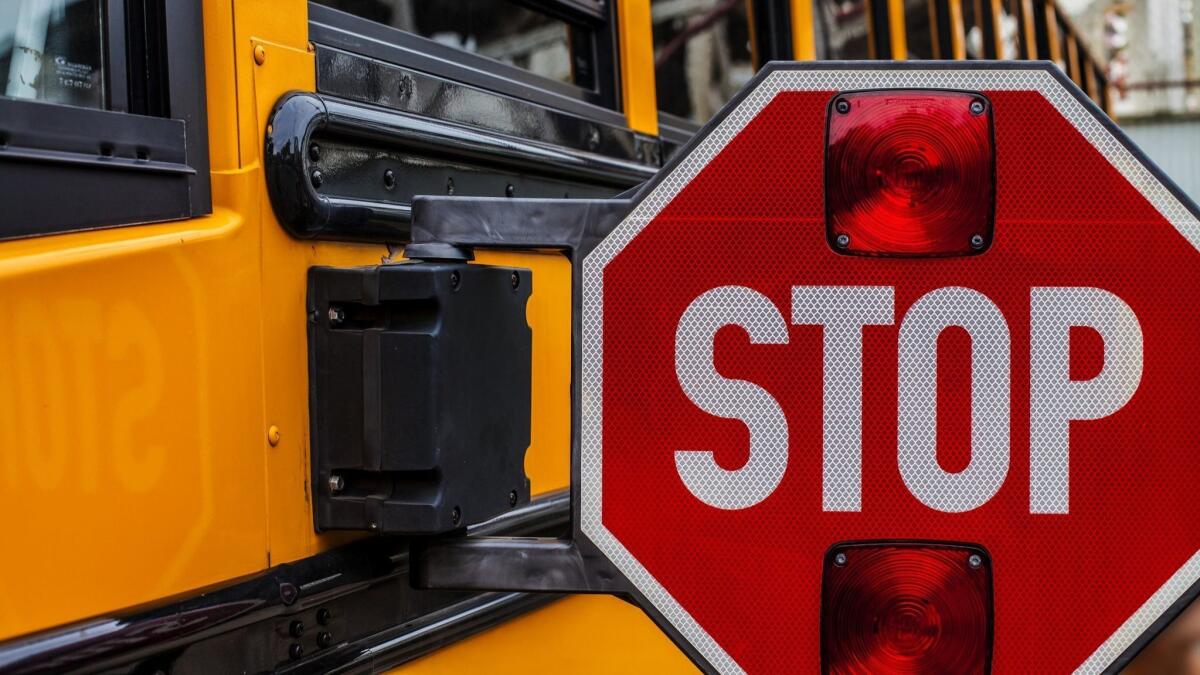Column: School safety is an issue that travels well beyond campus

- Share via
As local school board elections approach, a key issue that candidates have been addressing is school safety.
A rash of school shootings across the nation have put us all on edge. Voters naturally want to know what measures district officials have taken to keep students as secure as possible and how they plan to improve safety going forward.
While this is a difficult issue for many reasons, and one that must be addressed, it’s not the only aspect to student safety that warrants attention.
There are many other ways that schools are called upon to keep children safe, whether the threat comes from drugs, mental illness, bullying or a host of other problems. And when it comes to addressing these safety-related concerns, one question can be particularly confounding:
How much do we hold schools responsible for what students do and say while they’re off campus?
Until recently, schools were held to a straightforward standard: They were responsible for students “door to door” — that is, from the time students leave home to attend school or school-related functions, until they return home.
In decades past, schools did sometimes wrestle with how far their authority could stretch to include policing the speech and behavior of students beyond school boundaries.
In one landmark ruling from the 1960s, for example, the U.S. Supreme Court decided that a school’s attempt to punish students for wearing black armbands to protest the Vietnam War violated the students’ free speech rights.
In another influential case in the 1980s, the Supreme Court placed some limits on student speech, ruling that the use of sexualized messaging related to a student government campaign went too far.
Court decisions, however, historically tended to err on the side of limiting schools’ ability to extend their discipline policies to conduct off campus. Many rulings concluded that districts overstepped, upholding the concept that disciplinary power should only apply to actions and speech that directly and demonstrably effect the learning environment.
But times have changed, and questions about school authority that once appeared more clear cut are now anything but.
That’s because the internet age has brought with it many complicating factors for educators, not the least of which are such activities as online bullying, harassment and threats.
Because bad behavior so often now does not involve a physical presence, school administrators and teachers are left to grapple with how to respond when such activities originate, or are largely carried out, online. After all, social media follow kids around all day long; it makes no difference where posts are entered.
Muddying the picture further is our ongoing philosophical debate about the very role of schools.
Should schools exist merely to educate students in basic curricula? Or is it appropriate for them to fill a broader role — as counselors, social workers, babysitters or even surrogate parents?
School leaders, while acknowledging the blurred lines in these complicated times, now view their responsibilities as requiring them to intervene in cases in which a student’s behavior outside campus violates school policy, disrupts the educational process, results in bullying, or of course, carries the risk of violence.
The Orange County Department of Education’s code of conduct, for instance, includes the following line:
“Students also may be subject to discipline, in accordance with law, Orange County Department of Education policy, or procedure, for any off-campus conduct during non-school hours, which poses a threat or danger to the safety of students, staff, or Orange County Department of Education property, or substantially disrupts school activities.”
“It is a different era,” said Phil D’Agostino, Newport-Mesa Unified School District’s director of student and community services.
“Now we’re seeing a lot of activity that doesn’t fall under that door-to-door behavior,” he said. The pressure on educators “to be in a parental role has never been more serious or demanding.”
Administrators now feel obligated to investigate whenever reports come to them about online bullying or shaming, threats of violence or inappropriate sexual messaging. Those investigations can lead to schools taking disciplinary measures, or to counseling services referrals. Sometimes information is shared with law enforcement.
“If there is a connection between the normal operation of a school and what happens outside of school, the law obligates administrators to take action,” D’Agostino said.
The changing landscape has also forced schools to take a more proactive role, spending greater amounts of time and resources on education campaigns that inform students and parents about everything from how to reduce cyber bullying and harassment to depression and suicide.
These problems are exacerbated, D’Agostino said, because students are being given cell phones at younger and younger ages, often without appropriate guardrails.
“On the internet, most bullying occurs when there’s no supervision,” he said.
“We don’t want to be the policemen of the internet,” he said, but if more parents were informed and vigilant, schools would have less cause to fill that role.
But the reality is that schools are increasingly expected to do more when it comes to creating a safe and secure environment, both in school and out, and that pressure will only increase.
That’s not to suggest that we let schools off the hook. Instead, parents and other community members must look to how we can best partner with and support school leaders as they try to navigate through these turbulent and dangerous times.
Patrice Apodaca is a former Newport-Mesa public school parent and former Los Angeles Times staff writer. She lives in Newport Beach.
All the latest on Orange County from Orange County.
Get our free TimesOC newsletter.
You may occasionally receive promotional content from the Daily Pilot.






